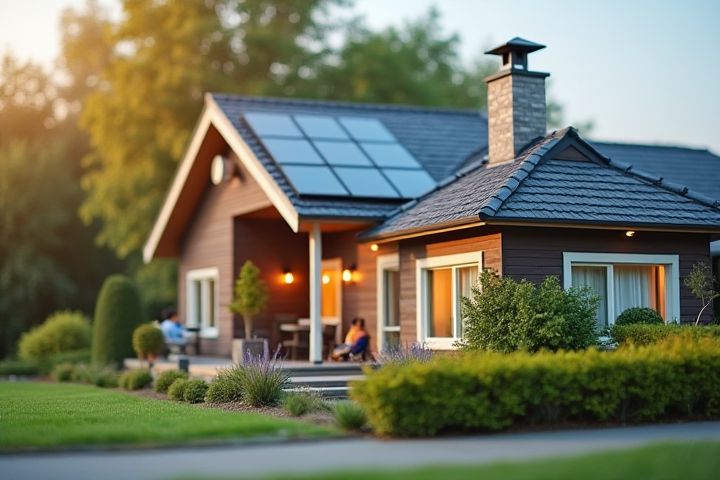
Installing energy-efficient appliances, such as ENERGY STAR-rated refrigerators and washing machines, can significantly reduce your overall energy consumption. Consider upgrading your insulation to minimize heat loss during the winter months and keep your home cooler in the summer, which lowers your heating and cooling bills. Utilizing programmable thermostats enables you to adjust temperatures automatically based on your schedule, maximizing energy savings when you're not home. Switching to LED lighting offers a long lifespan and uses up to 80% less energy compared to traditional incandescent bulbs. Finally, performing regular maintenance on HVAC systems ensures they operate efficiently, further helping to curtail energy costs.
How To Reduce Energy Costs In A House
Insulate walls and attics.
Insulating walls can significantly decrease energy costs by minimizing heat loss or gain, with optimal insulation levels often recommended between R-13 and R-30 depending on your climate zone. Attic insulation, ideally achieving R-30 to R-60, helps maintain a consistent temperature, which can lead to savings of 10% to 50% on heating and cooling bills. By sealing gaps and adding insulation material such as fiberglass or spray foam, you effectively reduce the load on your heating and cooling systems. You can expect a return on investment typically within 3-5 years as your energy costs decrease steadily each month.
Install energy-efficient windows.
Installing energy-efficient windows can significantly lower your household energy costs by minimizing heat transfer and reducing reliance on heating and cooling systems. These windows are designed with advanced features such as double or triple glazing, low-emissivity (Low-E) coatings, and insulated frames that enhance thermal performance. By preventing drafts and maintaining a stable indoor temperature, your home becomes more comfortable while also decreasing your energy bills. Upgrading to energy-efficient windows can yield substantial savings over time, making it a worthwhile investment for your home.
Use programmable thermostats.
Programmable thermostats allow you to customize your home's heating and cooling schedule, reducing energy consumption when you're not home. By setting the thermostat to a higher temperature in summer or a lower temperature in winter during your absence, you can significantly lower your utility bills. Smart programmable thermostats can learn your habits and optimize settings for efficiency, further decreasing energy costs. For maximum savings, you can also combine this with regular maintenance of your HVAC system to ensure it operates efficiently.
Switch to LED lighting.
Switching to LED lighting can cut your lighting energy costs by up to 75% compared to traditional incandescent bulbs. LED bulbs last about 25,000 hours, significantly reducing the frequency and cost of replacements. By replacing just 10 of your most-used bulbs, you could save approximately $100 annually on your electricity bill. Choosing ENERGY STAR-certified LED products ensures optimal performance and long-term savings, making it a smart investment for your home.
Seal doors and windows.
Sealing doors and windows can significantly reduce your energy costs, often decreasing utility bills by 10% to 20%. Use weatherstripping to fill gaps around movable parts, ensuring a tight seal that prevents drafts, which can account for up to 30% of heating and cooling losses in a home. Installing caulking around fixed windows and door frames can eliminate air leaks, enhancing your home's energy efficiency. By investing time and small amounts of money in these simple yet effective solutions, you can create a more comfortable living environment while lowering your energy expenses.
Utilize solar panels.
Utilizing solar panels can significantly reduce your energy costs, with potential savings of up to 70% on electricity bills. In the United States, solar installations increased by 20% in 2022, highlighting their growing popularity and effectiveness. By installing a solar energy system, you can harness renewable energy, which not only decreases reliance on fossil fuels but also allows you to take advantage of government incentives, such as tax credits that can cover 26% of installation costs. Investing in solar panels typically leads to a return on investment within five to seven years, providing long-term financial benefits while promoting sustainability.
Upgrade to energy-efficient appliances.
Upgrading to energy-efficient appliances can significantly lower your energy costs, with savings of 10-50% compared to standard models. Look for ENERGY STAR(r) certified appliances, as they meet strict efficiency guidelines set by the U.S. Environmental Protection Agency. For instance, an ENERGY STAR refrigerator uses about 15% less energy than a non-certified model, reducing your annual energy bill by approximately $250. Investing in these appliances not only saves you money but also lessens your carbon footprint, contributing to a more sustainable environment.
Reduce water heater temperature.
Lowering the temperature of your water heater can significantly decrease energy costs. Setting the thermostat to 120 degrees Fahrenheit, instead of the standard 140, limits the energy required to heat water, which can lead to substantial savings on your utility bill. This adjustment not only conserves energy but also reduces the risk of scalding, making it a safer option for households with children. By implementing this simple change, you can enhance both energy efficiency and safety in your home.
Implement smart home technology.
Implementing smart home technology can significantly reduce your energy costs by optimizing energy consumption throughout your home. Smart thermostats, for instance, learn your heating and cooling preferences, adjusting temperatures automatically to save energy when you're away. Smart lighting systems can be programmed to turn off when rooms are unoccupied or use motion sensors to minimize wastage. By integrating devices like smart plugs and energy monitors, you can track usage patterns and manage appliances more efficiently, ultimately lowering your utility bills.
Perform regular HVAC maintenance.
Performing regular HVAC maintenance can lead to significant energy cost reductions in your home. Schedule professional inspections at least once a year, ensuring that filters, coils, and ducts are clean and functioning efficiently. By replacing or cleaning filters every 1-3 months, you can improve air quality and system efficiency, potentially lowering energy consumption by 5-15%. Additionally, upgrading to a programmable thermostat can optimize HVAC usage, allowing you to save approximately 10-15% on your heating and cooling bills annually.
